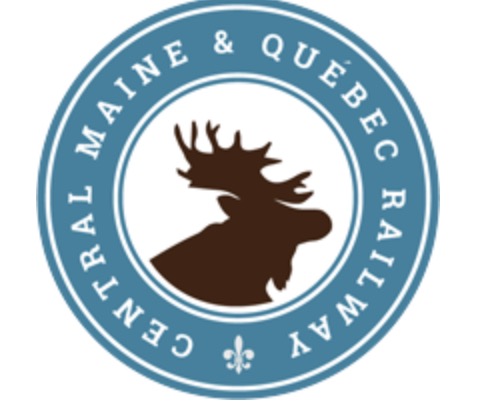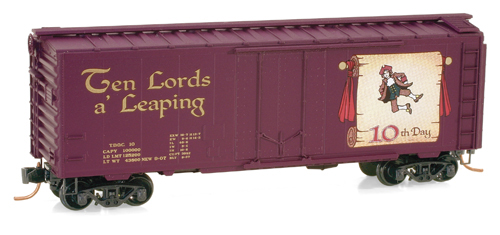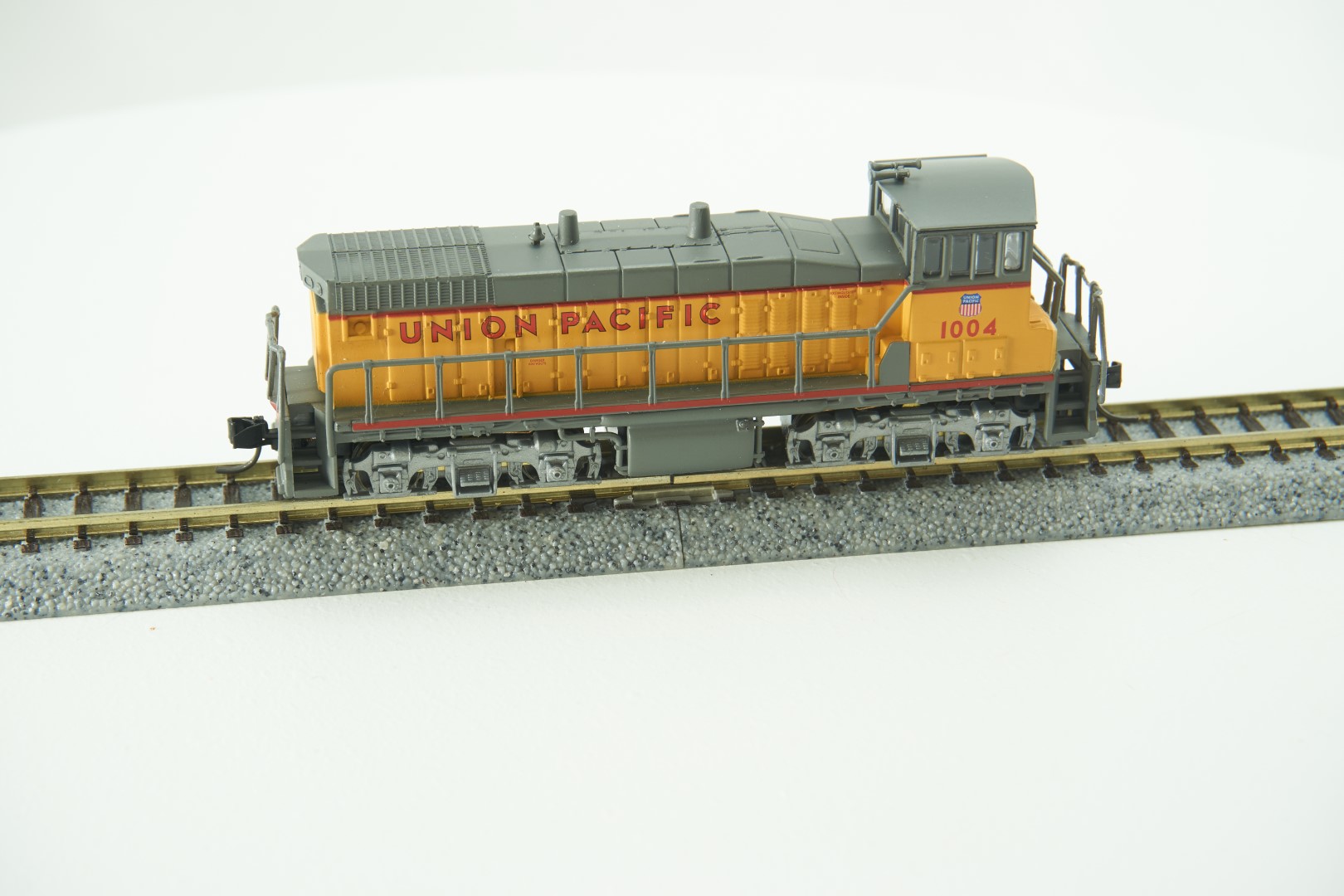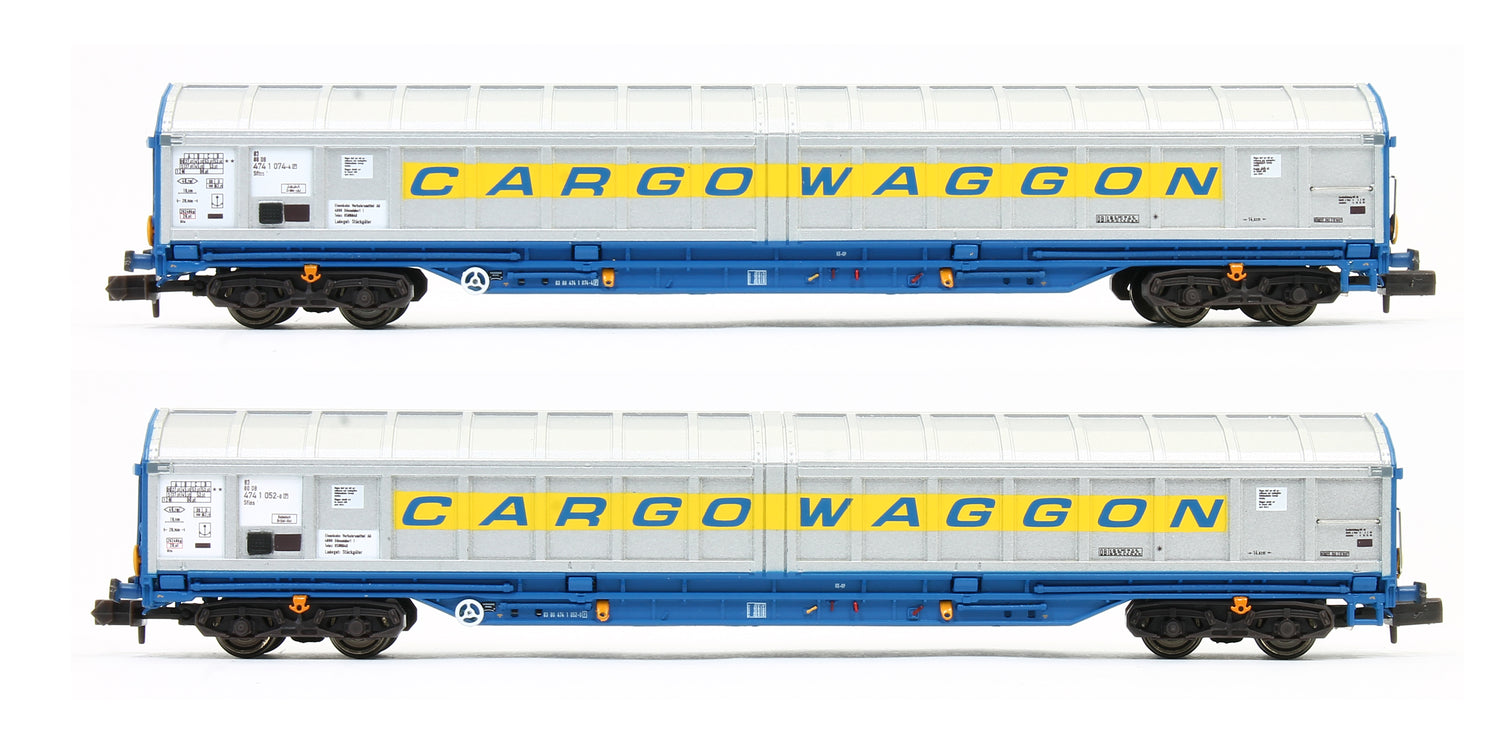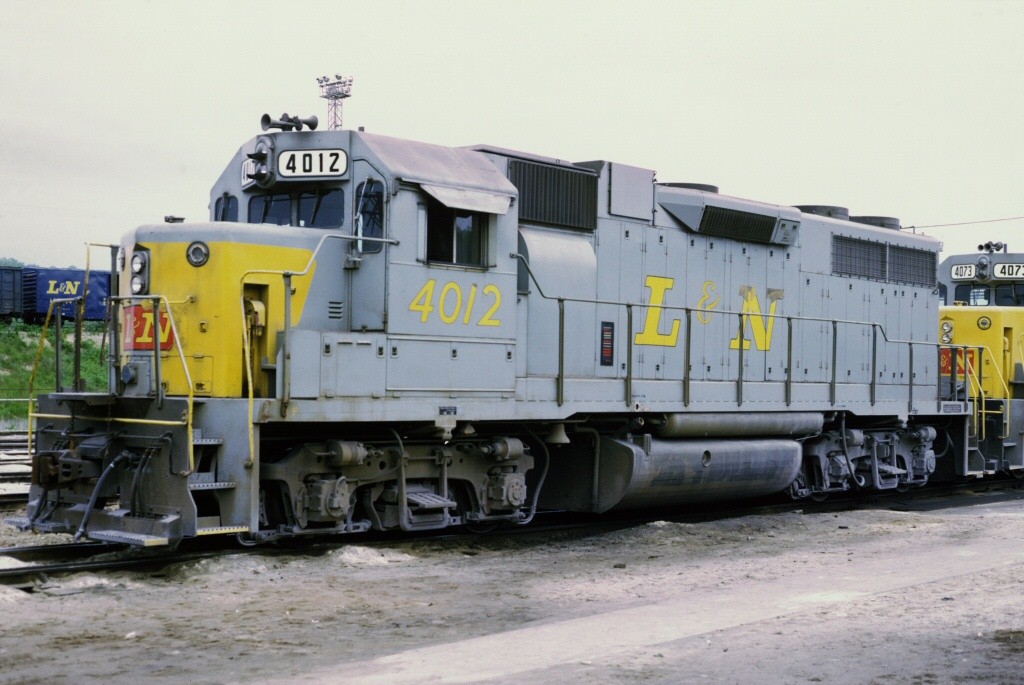Atlas - 40 005 620 - Locomotive, Diesel, EMD GP38 - Central Maine & Quebec - 3812
Click to see the details
market
| Production Type | Announced |
| Stock Number | 40 005 620 |
| Secondary Stock Number | 40005620 |
| Original Retail Price | $269.95 |
| Brand | Atlas |
| Manufacturer | Atlas |
| Body Style | Atlas Diesel Engine GP38 |
| Image Provider's Website | Link |
| Prototype Vehicle | Locomotive, Diesel, EMD GP38 (Details) |
| Road or Company Name | Central Maine & Quebec (Details) |
| Reporting Marks | CMQ |
| Road or Reporting Number | 3812 |
| Paint Color(s) | Grey & Blue with White Stripes |
| Print Color(s) | White |
| Paint Scheme | Low Nose - Front and Rear Ditch Lights |
| Coupler Type | AccuMate Magnetic Knuckle |
| Coupler Mount | Body-Mount |
| Wheel Type | Chemically Blackened Metal |
| Wheel Profile | Small Flange (Low Profile) |
| DCC Readiness | DC/DCC Dual Mode Decoder w/Sound |
| Announcement Date | 2023-01-28 |
| Release Date | 2024-06-01 |
| Item Category | Locomotives |
| Model Type | Diesel |
| Model Subtype | EMD |
| Model Variety | GP38 |
| Prototype Region | North America |
| Prototype Era | NA Era IV: 2nd Gen Diesel (1958 - 1978) |
| Scale | 1/160 |
Specific Item Information:
ESU SOUND-EQUIPPED
Model Information:
The Atlas GP38 is made in China and has always been made in China. These mechanisms run fine but the first releases (1996) do not support drop in decoders. Both versions use a dual-flywheel, split frame chassis with a 5-Pole skew-wound motor.
DCC Information:
Early Chinese versions are DCC-friendly requiring a complicated split-board DCC install. Later versions are DCC-Ready accepting a 1 Amp N Scale Mobile Decoder for Atlas N-Scale GP40-2, U25B, SD35, Trainmaster, B23-7 and others (DN163A0) from digitrax.com. Unfortunately, the only way to tell which kind you have is to remove the shell and check the chassis. If it has two small lightboards, you have an old one in your hand. A single long lightboard indicates a DCC-Ready chassis.
As of the 2001 run, this model was also offered with factory-installed DCC decoder, first Lenz LE063XF and then (circa 2010s) a NCE decoder.
Since the 2018 run, it is only offered with ESU Loksound sound decoder without DCC no-sound option. So if you want a DCC no-sound, you'll need to install a decoder by yourself.
As of the 2001 run, this model was also offered with factory-installed DCC decoder, first Lenz LE063XF and then (circa 2010s) a NCE decoder.
Since the 2018 run, it is only offered with ESU Loksound sound decoder without DCC no-sound option. So if you want a DCC no-sound, you'll need to install a decoder by yourself.
Prototype History:
The EMD GP38 is a 4-axle diesel-electric locomotive built by General Motors Electro-Motive Division between January 1966 and December 1971. The locomotive's power was provided by an EMD 645 16-cylinder engine which generated 2,000 horsepower (1.49 MW). The company built 706 GP38s for North American railroads. In 1972, it was replaced by an updated model, the GP38-2.
From Wikipedia
From Wikipedia
Road Name History:
This is a regional railroad that appeared, gained the loyalty of many customers, adopted a new paint scheme that became an instant classic, painted a “Heritage” engine and then merged into a connecting Class One railroad, all in less time than it takes to go through one lap of Railroad Of The Day.
In 2014, a subsidiary of Fortress Investment Group (who also owned Florida East Coast and owned RailAmerica before selling it to Genesee & Wyoming) bid for and was awarded by the bankruptcy trustees the rail lines of the Montreal Maine & Atlantic. The new company was called Central Maine & Quebec Railway. The MM&A had slipped into bankruptcy after a runaway oil train derailed and caught fire, killing 47 people and doing 200 million dollars in damage to downtown Lac-Mégantic, Quebec.
The CMQ ran 481 miles of line from Montreal, Quebec east to Brownville Junction, Maine where the line split. One line headed northeast to Millinocket where it connected with Maine Northern’s network of branches serving the northeastern Maine frontier. The other line turned south to Bangor and the harbor at Searsport. There were also three branches on the Quebec end, one of which slipped over the border to serve Northern Vermont. The CMQ spent millions over the next three years, upgrading track. In the meantime, no oil trains traversed the line. The sale of the line did not include the locomotives (which were returned to lessors or auctioned separately.) CMQ leased a number of diesels to get the operation going. The arrival of 10 former Canadian Pacific SD40F’s led to adoption of the new blue and silver/gray paint scheme in 2016. This paint scheme spread to most of the fleet including a pair to AC4400CW’s leased from CIT. One of the SD40F’s was painted for CM&Q ancestor Bangor & Aroostook.
In December of 2019, Central Maine & Quebec was sold to Canadian Pacific. Operations were officially merged on June 4, 2020. Today's collection of CMQ photos covers 2014 to 2017. We'll have more tomorrow.
In 2014, a subsidiary of Fortress Investment Group (who also owned Florida East Coast and owned RailAmerica before selling it to Genesee & Wyoming) bid for and was awarded by the bankruptcy trustees the rail lines of the Montreal Maine & Atlantic. The new company was called Central Maine & Quebec Railway. The MM&A had slipped into bankruptcy after a runaway oil train derailed and caught fire, killing 47 people and doing 200 million dollars in damage to downtown Lac-Mégantic, Quebec.
The CMQ ran 481 miles of line from Montreal, Quebec east to Brownville Junction, Maine where the line split. One line headed northeast to Millinocket where it connected with Maine Northern’s network of branches serving the northeastern Maine frontier. The other line turned south to Bangor and the harbor at Searsport. There were also three branches on the Quebec end, one of which slipped over the border to serve Northern Vermont. The CMQ spent millions over the next three years, upgrading track. In the meantime, no oil trains traversed the line. The sale of the line did not include the locomotives (which were returned to lessors or auctioned separately.) CMQ leased a number of diesels to get the operation going. The arrival of 10 former Canadian Pacific SD40F’s led to adoption of the new blue and silver/gray paint scheme in 2016. This paint scheme spread to most of the fleet including a pair to AC4400CW’s leased from CIT. One of the SD40F’s was painted for CM&Q ancestor Bangor & Aroostook.
In December of 2019, Central Maine & Quebec was sold to Canadian Pacific. Operations were officially merged on June 4, 2020. Today's collection of CMQ photos covers 2014 to 2017. We'll have more tomorrow.
Brand/Importer Information:
In 1924 Stephan Schaffan, Sr. founded the Atlas Tool Company in Newark, New Jersey. In 1933 his son, Stephan Schaffan, Jr., came to work for his father at the age of sixteen. Steve Jr. built model airplanes as a hobby and frequented a local hobby shop. Being an enterprising young man, he would often ask the owner if there was anything he could do to earn some extra spending money. Tired of listening to his requests, the hobby-store owner threw some model railroad track parts his way and said, "Here, see if you can improve on this".
In those days, railroad modelers had to assemble and build everything from scratch. Steve Jr. created a "switch kit" which sold so well, that the entire family worked on them in the basement at night, while doing business as usual in the machine shop during the day.
Subsequently, Steve Jr. engineered the stapling of rail to fiber track, along with inventing the first practical rail joiner and pre-assembled turnouts and flexible track. All of these products, and more, helped to popularize model railroading and assisted in the creation of a mass-market hobby. The budding entrepreneur quickly outgrew the limitations of a basement and small garage operation. Realizing they could actually make a living selling track and related products, Steve and his father had the first factory built in Hillside, New Jersey at 413 Florence Avenue in 1947. On September 30, 1949, the Atlas Tool Company was officially incorporated as a New Jersey company.
In 1985, Steve was honored posthumously for his inventions by the Model Railroad Industry Association and was inducted into the Model Railroad Industry Hall of Fame in Baltimore, Maryland. In addition, Steve was nominated and entered into the National Model Railroad Association Pioneers of Model Railroading in 1995.
In the early 1990s, the Atlas Tool Company changed its name to Atlas Model Railroad Company, Inc.
In those days, railroad modelers had to assemble and build everything from scratch. Steve Jr. created a "switch kit" which sold so well, that the entire family worked on them in the basement at night, while doing business as usual in the machine shop during the day.
Subsequently, Steve Jr. engineered the stapling of rail to fiber track, along with inventing the first practical rail joiner and pre-assembled turnouts and flexible track. All of these products, and more, helped to popularize model railroading and assisted in the creation of a mass-market hobby. The budding entrepreneur quickly outgrew the limitations of a basement and small garage operation. Realizing they could actually make a living selling track and related products, Steve and his father had the first factory built in Hillside, New Jersey at 413 Florence Avenue in 1947. On September 30, 1949, the Atlas Tool Company was officially incorporated as a New Jersey company.
In 1985, Steve was honored posthumously for his inventions by the Model Railroad Industry Association and was inducted into the Model Railroad Industry Hall of Fame in Baltimore, Maryland. In addition, Steve was nominated and entered into the National Model Railroad Association Pioneers of Model Railroading in 1995.
In the early 1990s, the Atlas Tool Company changed its name to Atlas Model Railroad Company, Inc.
Item created by: CNW400
on 2023-02-01 10:21:02
If you see errors or missing data in this entry, please feel free to log in and edit it. Anyone with a Gmail account can log in instantly.
If you see errors or missing data in this entry, please feel free to log in and edit it. Anyone with a Gmail account can log in instantly.




